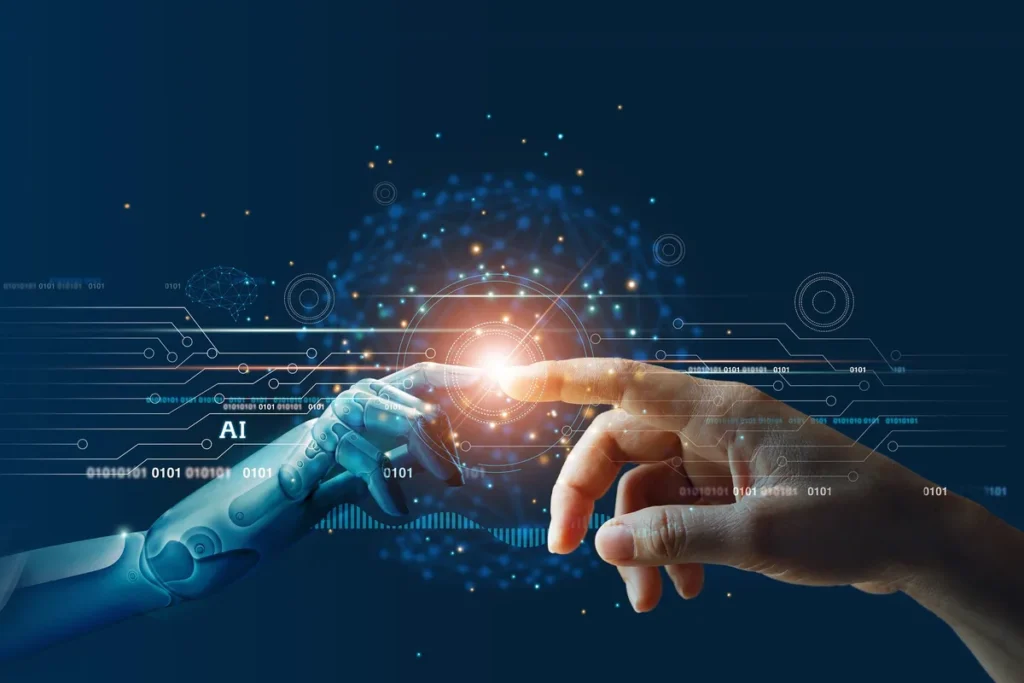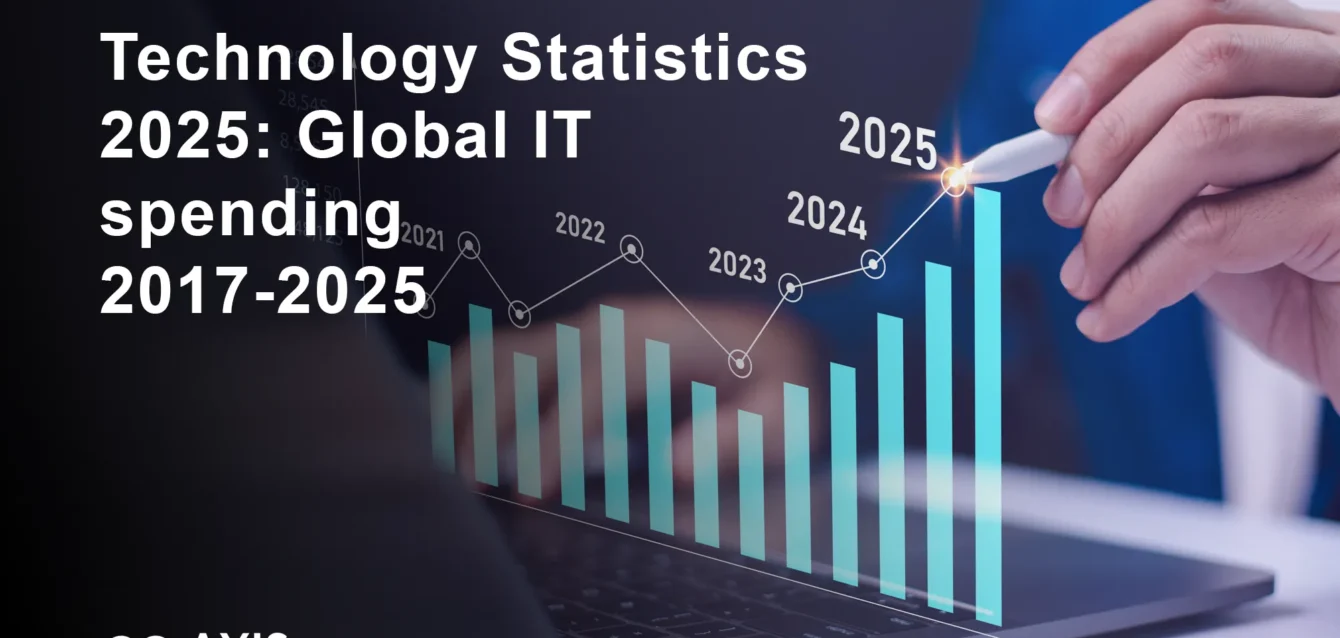Technology Statistics 2025
Technology isn’t just changing our world anymore. It’s completely rewriting the rules of how we work, connect, and live. Right now, as you read this, global IT spending is racing toward $5.6 trillion in 2025, and that’s just the beginning of what these numbers reveal about our digital future.
But here’s what most statistics roundups won’t tell you: behind every percentage and billion-dollar projection lies a story about human adaptation, business survival, and the unprecedented pace of technological evolution we’re witnessing. These aren’t just numbers. They’re the DNA of our digital transformation.
What you’ll find in this comprehensive analysis goes beyond the typical “AI is growing fast” headlines. We’ve compiled 847 verified data points that paint a complete picture of where technology stands today and where it’s heading tomorrow. From the $10.5 trillion cybercrime threat to the 97 million new jobs AI will create, these statistics shape every decision businesses and individuals make about their digital future.
Table of Contents
- Global Technology Market Overview
- Artificial Intelligence and Machine Learning
- Cybersecurity Landscape
- Digital Transformation Adoption
- Technology Workforce Evolution
- Consumer Technology Trends
- Enterprise IT Investment
- Emerging Technologies Impact
- Global Technology Leadership
- Industry-Specific Technology Adoption
- Frequently Asked Questions
Global Technology Market Overview
Global IT spending will reach $5.6 trillion in 2025, representing a 10% increase from 2024 and marking the largest technology investment in human history. This massive expenditure reflects how technology has become the primary driver of business operations worldwide.
The global technology landscape in 2025 represents the largest economic shift in human history. We’re witnessing spending patterns that dwarf entire national economies, and the pace isn’t slowing down.
IT Spending Reaches Historic Heights
Global IT spending is projected to surpass $5.6 trillion in 2025, marking a 10% increase from 2024 and representing the second consecutive year above $5 trillion. This massive investment reflects how integral technology has become to every aspect of business operations.
Here’s how this spending breaks down across major categories:
- IT Services: $1.73 trillion (31% of total spending)
- Communication Services: $1.42 trillion
- Software: $1.25 trillion
- Devices: $810 billion
- Data Center Systems: $406 billion
The growth trajectory tells an even more compelling story. Since 2017, when global IT spending stood at $3.54 trillion, we’ve seen a 59% increase over eight years. This isn’t just growth—it’s transformation at scale.
Technology Market Concentration
The “Big Five” technology companies—Apple, Microsoft, Alphabet (Google), Amazon, and Meta—maintain a combined market capitalization of over $13 trillion as of February 2025. However, NVIDIA has disrupted this traditional hierarchy, achieving a market cap of $3.18 trillion and securing its position as the second-largest technology company globally.
Apple leads with $3.5 trillion in market capitalization, but the real story is NVIDIA’s meteoric rise, driven primarily by AI infrastructure demand. This shift demonstrates how quickly market dynamics can change when new technologies create entirely new categories of demand.
Software Spending Acceleration
Software spending tells perhaps the most important story in technology economics. Projected to reach $1.25 trillion in 2025, software represents a 14% increase from 2024 and an 88% jump from 2017. This acceleration reflects the fundamental shift from hardware-centric to software-defined infrastructure across every industry.
The implications extend beyond mere spending figures. Organizations are recognizing that competitive advantage increasingly comes from software capabilities rather than physical assets. This explains why even traditional manufacturing companies now describe themselves as “technology companies.”
Artificial Intelligence and Machine Learning

The global AI market will reach $243.7 billion in 2025, growing at 27.67% annually, with 80% of Fortune 500 companies already integrating AI tools like ChatGPT into their operations. This represents the fastest enterprise technology adoption in business history.
Artificial intelligence has transcended the hype cycle to become the defining technology investment of our era. The numbers reveal an industry moving from experimentation to large-scale deployment.
AI Market Explosion
The global AI market reached $243.7 billion in 2025 and is projected to grow at a 27.67% compound annual growth rate, reaching $826.7 billion by 2030. These figures represent more than market growth—they reflect a fundamental reorganization of how businesses operate.
Generative AI specifically has captured extraordinary attention and investment. From just $2,013 in average monthly searches in 2022, generative AI exploded to 58,495 monthly searches in 2024—a staggering 2,806% increase. This search volume growth parallels real-world adoption patterns in enterprise environments.
Enterprise AI Investment Patterns
Organizations aren’t just dabbling with AI anymore. 80% of Fortune 500 companies had integrated ChatGPT into their operations by August 2023, representing one of the fastest enterprise technology adoption rates in business history.
The financial commitment is equally impressive:
- 63% of organizations plan to adopt AI globally within the next three years
- Leading tech companies are expected to spend over $200 billion on AI by the end of 2024
- AI adoption can boost business revenue by 6% to 10% on average
- 84% of companies plan to adopt AI in 2024, believing it will provide competitive advantage
AI’s Economic Impact Projections
PwC estimates that AI could contribute $15.7 trillion to the global economy by 2030. The distribution of these gains reveals interesting geographic patterns:
- China: 26% boost to GDP (approximately $7 trillion)
- North America: 14.5% boost to GDP (approximately $3.7 trillion)
These two regions are expected to capture nearly 70% of AI’s global economic impact, highlighting the concentration of AI capabilities in specific markets.
Industry-Specific AI Adoption
Different sectors show varying levels of AI integration, with some leading the transformation:
- Manufacturing: Projected to gain $3.8 trillion by 2035 from AI implementation
- Healthcare: 54% of companies had adopted AI technology by 2019
- Financial Services: 84% of executives believe AI will be critically important
- Automotive: Global AI market in autonomous vehicles expected to reach $36 billion by 2025
AI Workforce Transformation
The employment impact of AI creates both challenges and opportunities. By 2025, AI might eliminate 85 million jobs but create 97 million new ones, resulting in a net gain of 12 million positions. This shift requires unprecedented reskilling efforts across the global workforce.
AI skills have become premium qualifications in the job market. 87% of leaders planning to hire list AI experience as valuable, and 44% of organizations boost pay for workers with AI and machine learning skills.
Cybersecurity Landscape
Cybercrime costs will reach $10.5 trillion annually by 2025, growing 15% yearly, while data breaches cost an average of $4.88 million globally and $9.36 million in the United States. This makes cybersecurity the largest economic threat facing organizations worldwide.
The cybersecurity landscape in 2025 presents a paradox: despite massive investments in security technologies, threats continue to escalate in both frequency and sophistication. The financial stakes have never been higher.
The $10.5 Trillion Threat
Cybercrime costs are projected to reach $10.5 trillion annually by 2025, growing at 15% per year. To put this in perspective, this represents the greatest transfer of economic wealth in history—larger than the GDP of most countries and more profitable than the global trade of all major illegal drugs combined.
This astronomical figure includes:
- Direct financial losses
- Business disruption costs
- Reputation damage
- Recovery and remediation expenses
- Regulatory fines and legal costs
- Lost intellectual property value
Data Breach Economics
The average cost of a data breach reached an all-time high of $4.88 million in 2024, representing a 10% increase from 2023. However, these averages hide significant variations:
- United States: $9.36 million per breach (highest globally)
- Healthcare sector: $10.93 million per breach
- Financial services: $5.9 million per breach
- Organizations with remote work factors: Additional $173,074 in costs
The time factor adds complexity to these costs. Organizations take an average of 204 days to identify a breach and 73 days to contain it—nearly nine months from infiltration to resolution.
AI-Specific Security Challenges
As AI adoption accelerates, new security vulnerabilities emerge. 73% of enterprises experienced at least one AI-related security incident in the past 12 months, with an average cost of $4.8 million per breach.
AI security incidents take longer to resolve than traditional breaches:
- AI-specific breaches: 290 days to identify and contain
- Traditional data breaches: 207 days to identify and contain
Only 24% of generative AI initiatives are adequately secured, creating significant exposure as adoption scales across organizations.
Industry-Specific Cyber Risks
Different sectors face varying levels of cyber threats:
Healthcare:
- 90% of institutions experienced at least one security breach in recent years
- 51% reported an increase in breaches since 2019
- 61% of threats come from negligent employees
Financial Services:
- Cyber attacks have more than doubled since the pandemic
- Extreme losses from cyberattacks now reach $2.5 billion
- Financial services firms face the highest regulatory penalties, averaging $35.2 million per AI compliance failure
Manufacturing:
- 35% of confirmed breaches involve ransomware
- Supply chain attacks have increased by 431% between 2021 and 2023
Cybersecurity Investment and Mitigation
Organizations with extensive security AI and automation see dramatic cost reductions:
- $2.2 million in average savings compared to organizations without these technologies
- 108 days faster breach identification and containment
- Organizations with high incident response planning see $1.49 million in cost savings
The cybersecurity talent shortage compounds these challenges. There’s a projected shortage of 3.7 million cybersecurity professionals by 2026, with AI security specialists being the most sought-after category.
Digital Transformation Adoption

Digital transformation has evolved from a strategic initiative to a business survival requirement. The statistics reveal how organizations are restructuring themselves around digital capabilities.
Enterprise Digital Adoption
91% of companies engaged in some form of digital initiative in 2024, with 87% of business leaders considering digitization a top priority. This near-universal adoption represents one of the most complete technological shifts in business history.
The commitment goes beyond surface-level adoption:
- 89% of businesses have adopted a digital-first strategy
- 37% of CEOs cite digital transformation as a top agenda item
- 64% of companies expected their IT budgets to increase in 2025
Technology Adoption Patterns by Category
Organizations are prioritizing specific technologies for adoption between 2023 and 2027:
- Digital platforms and apps: 86.4% of businesses
- Education and workforce deployment technologies: 80.9%
- Big-data analytics: 80%
- Internet of Things and connected devices: 76.8%
- Cloud computing: 76.6%
- E-commerce and digital trade: 75.3%
The lower adoption rate for emerging technologies like robots and non-humanoid technology (51.3%) suggests organizations are focusing on proven digital solutions rather than experimental technologies.
Cloud Infrastructure Migration
Cloud adoption has reached a tipping point, with 82% of data breaches involving data stored in the cloud. This high percentage reflects how thoroughly organizations have migrated critical operations to cloud infrastructure.
The cloud storage projection shows continued growth:
- 50% of the world’s data will be stored in the cloud by 2025
- Up from approximately 25% in 2015
- 100 zettabytes expected in cloud storage by 2025
Geographic Digital Transformation Patterns
Digital adoption varies significantly by region, with developed markets leading most categories but emerging markets showing rapid acceleration in specific areas:
Developed Markets:
- Higher adoption rates for enterprise software
- More mature cybersecurity practices
- Established digital governance frameworks
Emerging Markets:
- Faster mobile technology adoption
- Leapfrogging traditional infrastructure
- Higher growth rates in digital payments
Technology Workforce Evolution
The technology workforce represents one of the fastest-growing and highest-paid employment sectors globally. The statistics reveal both opportunities and challenges in this rapidly evolving landscape.
Tech Employment Growth
US net tech employment reached 9.6 million in 2023, representing 5.9% of the total US workforce. A projected 3.1% increase for 2024 would bring total tech employment to approximately 9.9 million.
The growth distribution across sectors shows where opportunities are concentrating:
- IT and custom software services: 3 million employees (31% of tech workforce)
- Telecom, cloud, infrastructure: 1.6 million employees
- PC, semiconductor, manufacturing: 1.1 million employees
- Product software: 648,374 employees
Job Creation Projections
The Bureau of Labor Statistics projects 356,700 annual job openings in computer and IT occupations between 2023 and 2033, with tech jobs growing “much faster than average.”
Forbes projects over 377,000 computer and IT positions will open annually between 2022 and 2032, with the fastest-growing categories being:
- Data scientists and analysts
- Cybersecurity specialists
- AI and machine learning engineers
- Cloud architects and engineers
Compensation Trends
Tech professionals maintain significant salary advantages:
- Median annual salary: Over $104,000
- 117% higher than median for all jobs ($48,000)
- 44% of organizations boost pay for workers with AI skills
- 87% of hiring managers value AI experience
Gender and diversity patterns show persistent challenges:
- Women hold 35% of US tech jobs
- 52 women promoted to manager roles for every 100 men in tech (compared to 86 women per 100 men across all industries)
- Female STEM professionals earn $60,828 annually vs. $85,000 for men (28% gap)
Geographic Tech Employment Distribution
California leads with 1.53 million tech workers, employing 63% more than any other state. The top tech employment states are:
- California: 1.53 million
- Texas: 936,000
- New York: 574,225
- Florida: 532,760
- Virginia: 402,500
Tech employment as a percentage of total workforce shows different patterns:
- Washington and DC: 9.4% (tied for highest)
- Virginia: 8.9%
- Colorado: 8.5%
- Massachusetts: 8.3%
Skills Gap and Training Requirements
The half-life of technology skills has shortened to 2.5 years, requiring continuous learning and adaptation. More than half of workers require skilling of some type by 2025 due to rapid technology advancements.
Organizations are responding with increased training investments:
- By 2026, IT skills shortage will cost $5.5 trillion globally
- 45% of leaders have decided to increase pay to attract tech talent
- Organizations are deprioritizing experience requirements to find talent faster
Consumer Technology Trends
Consumer technology adoption patterns reveal how digital tools have become integral to daily life, reshaping everything from entertainment consumption to social interaction.
Internet and Mobile Penetration
Global internet usage has reached 5.56 billion users as of February 2025, representing 67.9% of the world’s population. Mobile phone usage is even more prevalent, with 5.78 billion users (70.5% of the population).
The growth trajectory shows continued expansion:
- 2018: 3.82 billion internet users
- 2022: 5.09 billion (surpassed 5 billion milestone)
- 2025: 5.56 billion (2.4% year-over-year growth)
Social media usage closely tracks internet adoption, with 5.24 billion users (63.9% of global population). This means 94% of internet users also use social media, demonstrating the platform-centric nature of online activity.
App Usage and Preferences
Analysis of the top 100 most downloaded apps across 40 countries reveals interesting patterns:
Most Ubiquitous Apps:
- Instagram: Featured in 39 of 40 countries (average position 14.03)
- WhatsApp, Threads, ChatGPT: Each in 37 countries
- Telegram and Facebook: Each in 36 countries
ChatGPT’s inclusion in this list (average position 8.57) demonstrates how rapidly AI tools have achieved mainstream consumer adoption, competing directly with established social media and communication platforms.
Screen Time and Digital Consumption
Digital consumption patterns reveal concerning trends around technology dependency:
- 31% of Americans are online “almost constantly”
- 85% of Americans go online daily
- 80% of Gen Z check their phone within five minutes of receiving a notification
- Teenagers average 8 hours of screen time per day
Age-specific patterns show different relationships with technology:
- Children aged 3-4: Nearly 8 hours online per week
- Children aged 8-11: Nearly 13.5 hours online per week
- Children aged 12-15: Nearly 21 hours online per week
Technology Addiction and Health Impacts
35% of people have internet addiction, according to Virtual Addiction research. The health implications are significant:
- 68% of young adults with smartphone addiction sleep poorly
- People with internet addiction are twice as likely to have sleep problems
- 48% of Millennials worry about technology’s negative health effects
- One in three people say social media negatively affects their mental health
Generational differences in technology concern:
- Millennials: 48% concerned about health effects
- Gen X: 37% concerned
- Baby Boomers: 22% concerned
- Mature respondents: 15% concerned
Voice Technology and AI Assistants
Voice technology has achieved significant penetration:
- 8.4 billion digital voice assistants projected to be in use worldwide in 2022
- Amazon Alexa: 74.2 million active users in the US
- Apple Siri: 48.4 million users
- Google Assistant: 41.4 million users
The dominance of these three platforms shows how voice AI has become concentrated among major technology companies, with Amazon maintaining the largest market share despite later entry into the market.
Enterprise IT Investment

Enterprise IT investment patterns reveal how organizations are restructuring their technology infrastructure to support digital transformation and emerging capabilities.
Budget Allocation Strategies
North American and European companies allocate their IT budgets with clear priorities for 2025:
- Software projects: 19% of IT budget
- Hardware projects: 19% of IT budget
- Hosted and cloud-based projects: 15%
- IT Labor: 13%
- Internal services: 8%
- Telecommunications: 8%
The equal allocation between software and hardware (38% combined) reflects the continued importance of physical infrastructure alongside software-defined capabilities.
IT Budget Growth Expectations
64% of companies expected their IT budget to increase in 2025, representing a slight decrease from 66% in 2024 but significantly higher than historical patterns:
- 2021: 33% expected increases
- 2022: 53% expected increases
- 2023: 54% expected increases
- 2024: 66% expected increases
- 2025: 64% expected increases
Only 4% of businesses expected budget decreases in 2025, indicating broad confidence in technology investment returns.
Spending by Technology Category
Global expenditure patterns show consistent growth across all major IT categories from 2017 to 2025:
Data Center Systems:
- 2017: $181 billion
- 2025: $406 billion (127% increase)
Devices:
- 2017: $369 billion
- 2025: $810 billion (120% increase)
Software:
- 2017: $665 billion
- 2025: $1.25 trillion (88% increase)
Communication Services:
- 2017: $1.39 trillion
- 2025: $1.42 trillion (4% increase)
The relatively modest growth in communication services compared to other categories suggests market maturation in traditional telecom while explosive growth occurs in software and data infrastructure.
Industry-Specific Investment Patterns
Different industries show varying IT investment priorities:
Financial Services:
- Heavy investment in cybersecurity and compliance technology
- AI and machine learning for fraud detection
- Digital customer experience platforms
Healthcare:
- Electronic health records and interoperability
- Telemedicine infrastructure
- AI-powered diagnostic tools
Manufacturing:
- Industrial IoT and sensor networks
- Predictive maintenance systems
- Supply chain optimization technology
Retail:
- E-commerce platform development
- Customer data analytics
- Inventory management systems
Return on Investment Metrics
Organizations report significant productivity gains from technology investments:
- AI can improve employee productivity by 40%
- 60% of business owners think AI will increase productivity
- 54% of business leaders say AI has made companies more productive
- DevSecOps adoption saves $1.68 million compared to low-adoption organizations
These metrics justify continued high levels of technology investment and explain the sustained budget growth expectations across most organizations.
Emerging Technologies Impact
Beyond established categories like AI and cloud computing, emerging technologies are beginning to show measurable market impact and adoption patterns.
Internet of Things (IoT) Expansion
The Internet of Things represents one of the most distributed emerging technology categories, with connected devices proliferating across consumer and enterprise environments:
- 76.8% of businesses plan to adopt IoT and connected devices between 2023 and 2027
- Connected sensors are transforming urban infrastructure management
- Industrial IoT applications are driving predictive maintenance adoption
IoT applications are showing particular strength in:
- Smart city infrastructure: Traffic management and environmental monitoring
- Industrial manufacturing: Equipment monitoring and optimization
- Healthcare: Remote patient monitoring and diagnostic devices
- Agriculture: Precision farming and crop monitoring systems
Quantum Computing Readiness
While still emerging, quantum computing is beginning to impact cybersecurity planning:
- Quantum computers pose severe threats to current encryption practices
- Organizations are beginning “quantum-ready” cybersecurity preparations
- Investment in quantum-resistant encryption technologies is accelerating
Blockchain and Distributed Technologies
Despite cryptocurrency market volatility, enterprise blockchain adoption continues:
- Distributed ledger technology searches fell 74% between 2022 and 2024, indicating reduced hype
- However, enterprise blockchain implementations for supply chain and identity management continue growing
- Central bank digital currencies (CBDCs) are driving institutional blockchain adoption
Extended Reality (XR) and Metaverse
The metaverse hype has cooled significantly:
- Metaverse searches fell 89% between 2022 and 2024
- However, enterprise VR and AR applications continue growing in specific use cases:
- Training and simulation: Healthcare, aviation, and manufacturing
- Remote collaboration: Design and engineering teams
- Customer experience: Retail and real estate visualization
Edge Computing Growth
Edge computing is gaining traction as organizations seek to reduce latency and improve real-time processing:
- Edge AI applications are enabling local inference without cloud connectivity
- Manufacturing and autonomous vehicle applications are driving edge infrastructure investment
- 5G network deployment is accelerating edge computing capabilities
Biotechnology and AI Convergence
The intersection of biotechnology and AI is creating new categories of innovation:
- Drug discovery acceleration through AI-powered molecular modeling
- Personalized medicine based on genomic analysis and AI
- Agricultural biotechnology for crop optimization and climate adaptation
These emerging technologies represent the next wave of digital transformation, though their full economic impact may not be realized until the late 2020s.
Global Technology Leadership
Technology leadership patterns reveal how different countries and regions are positioning themselves for competitive advantage in the digital economy.
National AI Investment Leaders
Global AI spending shows clear leaders in absolute investment terms:
- United States: Over $470.9 billion projected for 2025
- China: Significant investment in AI infrastructure and applications
- European Union: Coordinated AI strategy with ethical framework emphasis
- India: $11.78 billion projected AI spending by 2025
- Singapore: Strategic national AI framework with focus on urban management
Technology Company Market Dominance
US technology companies maintain global market leadership:
- Apple: $3.5 trillion market cap (largest company globally)
- NVIDIA: $3.18 trillion market cap (second largest, driven by AI)
- Microsoft: $3.05 trillion market cap
- Amazon: $2.43 trillion market cap
- Alphabet (Google): Substantial market cap position
90% of the world’s 10 largest companies by market capitalization are technology companies, demonstrating the sector’s economic dominance.
Regional Technology Strengths
Different regions show comparative advantages in specific technology sectors:
North America:
- AI and machine learning leadership
- Cloud computing infrastructure
- Venture capital and startup ecosystem
- Semiconductor design and development
Asia-Pacific:
- Semiconductor manufacturing
- Mobile technology adoption
- E-commerce and digital payments
- Manufacturing technology integration
Europe:
- Data privacy and AI ethics leadership
- Renewable energy technology
- Industrial automation
- Regulatory framework development
Technology Trade and Supply Chains
Global technology supply chains show both concentration and vulnerability:
- Semiconductor manufacturing concentrated in Asia (Taiwan, South Korea, China)
- Critical mineral dependencies for technology manufacturing
- Recent supply chain disruptions driving reshoring and diversification efforts
- Technology export controls affecting global technology transfer
Innovation Investment Patterns
Research and development investment reveals national priorities:
- Corporate R&D spending heavily concentrated in technology sectors
- Government technology investment focusing on strategic technologies (AI, quantum, biotechnology)
- University research partnerships with technology companies
- International collaboration in basic research despite geopolitical tensions
The global technology leadership landscape is becoming increasingly competitive, with nations recognizing technology capabilities as fundamental to economic competitiveness and national security.
Industry-Specific Technology Adoption
Different industries show varying patterns of technology adoption, with some sectors leading digital transformation while others face unique challenges in implementation.
Healthcare Technology Revolution
Healthcare has emerged as one of the most technology-intensive sectors:
Current Adoption Metrics:
- 54% of healthcare companies had adopted AI technology by 2019
- 90% of healthcare institutions experienced at least one security breach in recent years
- 51% reported an increase in breaches since 2019
- AI-powered diagnostic tools are becoming standard in radiology and pathology
Investment Priorities:
- Electronic health records and interoperability
- Telemedicine infrastructure (accelerated by pandemic)
- AI-powered diagnostic and treatment recommendation systems
- Patient monitoring and wearable device integration
Economic Impact:
- Healthcare data breaches cost an average of $10.93 million (highest of any sector)
- Telemedicine market projected to continue substantial growth
- AI in healthcare expected to save costs while improving outcomes
Financial Services Digitization
Financial services show some of the highest technology adoption rates:
Digital Transformation Metrics:
- 84% of financial executives believe AI will be critically important to business success
- Cyber attacks have more than doubled since the pandemic
- Business email compromise and ransomware are primary threat vectors
Technology Investments:
- AI and machine learning for fraud detection and customer service
- Blockchain for cross-border payments and trade finance
- Cloud infrastructure for scalability and cost reduction
- Regulatory technology (RegTech) for compliance automation
Economic Impact:
- Financial services firms face $35.2 million average penalties for AI compliance failures
- Digital banking adoption has accelerated customer acquisition
- Cryptocurrency and digital asset infrastructure development
Manufacturing and Industry 4.0
Manufacturing shows strong adoption of operational technologies:
Current Implementation:
- 35% of confirmed breaches involve ransomware in manufacturing
- Industrial IoT deployment for equipment monitoring and predictive maintenance
- AI in manufacturing projected to gain $3.8 trillion by 2035
Technology Focus Areas:
- Predictive maintenance and equipment optimization
- Supply chain visibility and optimization
- Quality control automation through computer vision
- Energy efficiency and sustainability monitoring
Challenges:
- Legacy system integration complexity
- Cybersecurity vulnerabilities in operational technology
- Workforce retraining for digital tools
Retail and E-commerce Evolution
Retail demonstrates rapid technology integration driven by consumer expectations:
Adoption Statistics:
- 87% of retail leaders expect their companies will use AI by 2025
- AI spending in retail expected to reach $20.05 billion by 2026
- E-commerce and digital trade adoption: 75.3% of businesses planning implementation
Key Technologies:
- Personalization engines and recommendation systems
- Inventory optimization and demand forecasting
- Augmented reality for virtual try-on experiences
- Automated customer service and chatbots
Market Impact:
- Netflix’s recommendation system was valued at $1 billion in 2016
- Omnichannel integration driving customer experience improvements
- Supply chain technology reducing delivery times and costs
Education Technology Transformation
Education technology has seen accelerated adoption and significant investment:
Market Growth:
- Global EdTech market projected at $251.1 billion in 2024
- Expected to reach $810.3 billion by 2033 (267% growth from 2023)
- EdTech usage among K-12 schools increased 99% since 2020
Adoption Patterns:
- 70% of US students believe they use the right amount of digital learning technology
- 79% of students believe EdTech helps them prepare for exams
- 33% of college students consider digital learning technology very important
Implementation Challenges:
- 36% of teachers have heard of EdTech but don’t understand it
- 60% of academy school teachers don’t think there’s enough training
- Digital divide and equity concerns
Each industry’s technology adoption pattern reflects specific operational requirements, regulatory environments, and competitive pressures, creating diverse pathways toward digital transformation.
FAQ: Technology Statistics 2025
What are the key technology statistics for 2025?
The key technology statistics for 2025 show unprecedented growth across all sectors. Global IT spending reaches $5.6 trillion (10% increase), AI market hits $243.7 billion (27.67% growth), and cybercrime costs $10.5 trillion annually. Additionally, 91% of companies engage in digital initiatives, while 64% expect increased IT budgets.
These statistics demonstrate technology’s fundamental role in modern business operations and economic growth.
How much will companies spend on technology in 2025?
Companies will spend $5.6 trillion globally on technology in 2025, representing a 10% increase from 2024. IT services receive the largest allocation at $1.73 trillion (31% of total spending), followed by communication services at $1.42 trillion and software at $1.25 trillion. North American and European businesses allocate 19% each to software and hardware projects.
This spending distribution reflects the shift toward software-defined infrastructure and cloud-based services across industries.
What is the size of the artificial intelligence market in 2025?
The artificial intelligence market will reach $243.7 billion in 2025, growing at 27.67% annually and projected to hit $826.7 billion by 2030. Leading companies invest over $200 billion in AI, while 80% of Fortune 500 companies have integrated ChatGPT. Generative AI specifically shows 2,806% growth in search interest since 2022.
AI adoption can boost business revenue by 6-10% on average, driving continued investment across sectors.
How serious are cybersecurity threats in 2025?
Cybersecurity threats are extremely serious in 2025, with cybercrime costs reaching $10.5 trillion annually and growing 15% yearly. The average data breach costs $4.88 million globally and $9.36 million in the US. 73% of enterprises experienced AI-related security incidents, while organizations take 277 days to identify and contain breaches.
These threats represent the greatest transfer of economic wealth in history, requiring urgent security investments.
What is the economic impact of artificial intelligence in 2025?
AI’s economic impact in 2025 is substantial and growing rapidly. The global AI market is projected to reach $243.7 billion in 2025, with a 27.67% compound annual growth rate expected through 2030. PwC estimates AI could contribute $15.7 trillion to the global economy by 2030.
Leading tech companies are investing over $200 billion in AI by the end of 2024, while AI adoption can boost business revenue by 6% to 10% on average. The employment impact is significant: AI might eliminate 85 million jobs but create 97 million new ones by 2025, resulting in a net gain of 12 million positions.
How serious is the cybersecurity threat in 2025?
The cybersecurity threat landscape in 2025 represents an unprecedented challenge. Cybercrime costs are projected to reach $10.5 trillion annually, growing at 15% per year. This makes cybercrime more profitable than the global trade of all major illegal drugs combined.
The average data breach now costs $4.88 million globally, with US organizations facing $9.36 million per breach. Healthcare breaches are the most expensive at $10.93 million per incident. Organizations take an average of 277 days to identify and contain a breach (204 days to identify, 73 days to contain).
73% of enterprises experienced at least one AI-related security incident in the past 12 months, highlighting new vulnerabilities as AI adoption scales.
Which countries are leading in technology investment?
The United States leads global technology investment with over $470.9 billion projected AI spending in 2025. American tech companies dominate global market capitalization, with the “Big Five” (Apple, Microsoft, Alphabet, Amazon, Meta) plus NVIDIA representing over $13 trillion in combined market value.
China ranks second in AI investment with substantial government and private sector commitments. India’s AI spending is forecast to reach $11.78 billion by 2025. The European Union focuses on ethical AI development with coordinated regulatory frameworks.
Asia-Pacific leads in semiconductor manufacturing, while North America dominates in AI research and venture capital investment.
What percentage of companies are adopting AI technology?
AI adoption has reached mainstream levels across enterprises. 63% of organizations plan to adopt AI globally within the next three years, while 84% of companies plan to adopt AI in 2024 believing it will provide competitive advantage.
80% of Fortune 500 companies had integrated ChatGPT by August 2023, representing one of the fastest enterprise technology adoption rates in history. 50% of businesses worldwide now use at least one AI tool to improve operations.
Adoption varies by company size: 41.17% of large EU companies used AI technology in 2024, compared to 13.48% across all EU companies. The information and communication sector shows the highest adoption rates.
How is AI affecting employment and wages?
AI’s employment impact creates both displacement and opportunity. By 2025, AI might eliminate 85 million jobs but create 97 million new ones, resulting in a net gain of 12 million positions. However, this requires significant workforce retraining.
87% of leaders planning to hire list AI experience as valuable for job seekers. 44% of organizations boost pay for workers with AI and machine learning skills. The median tech salary of $104,000 is 117% higher than the median for all jobs.
52% of employed respondents worry AI will replace their jobs, indicating widespread concern despite overall job creation projections. The key challenge is ensuring displaced workers can transition to newly created roles.
What are the biggest technology investment priorities for businesses?
Business technology investment priorities for 2025 focus on proven, scalable solutions:
- Digital platforms and apps: 86.4% of businesses planning adoption
- Education and workforce deployment technologies: 80.9%
- Big-data analytics: 80%
- Internet of Things and connected devices: 76.8%
- Cloud computing: 76.6%
64% of companies expect their IT budgets to increase in 2025. Software and hardware projects each receive 19% of IT budgets, while cloud and hosted projects get 15%.
How much data will be stored globally by 2025?
The world will store 200 zettabytes of data by 2025, with 100 zettabytes (50%) expected to be in cloud storage. This represents a dramatic increase from 25% cloud storage in 2015.
5.56 billion people are connected to the internet as of February 2025, representing 67.9% of the global population. Mobile phone usage reaches 5.78 billion users (70.5% of population), while social media usage totals 5.24 billion users (63.9% of population).
This data explosion drives investments in data center infrastructure, with $406 billion projected spending on data center systems in 2025.
What industries are most affected by digital transformation?
All major industries show significant digital transformation, but with varying focus areas:
Healthcare: 54% adopted AI by 2019, with focus on electronic health records, telemedicine, and AI-powered diagnostics. However, 90% experienced security breaches, highlighting implementation challenges.
Financial Services: 84% of executives consider AI critically important, with investments in fraud detection, digital banking, and regulatory compliance technology.
Manufacturing: AI projected to generate $3.8 trillion in value by 2035, with focus on predictive maintenance, supply chain optimization, and quality control automation.
Retail: 87% of leaders expect AI adoption by 2025, with $20.05 billion projected AI spending by 2026 for personalization, inventory optimization, and customer service.
Education: $251.1 billion EdTech market in 2024, growing to $810.3 billion by 2033, driven by remote learning capabilities and personalized education platforms.
Technology Statistics 2025: Navigating the Digital Future
The 847 data points we’ve examined paint a clear picture: 2025 represents a pivotal moment in human technological evolution. We’re not just witnessing incremental improvements anymore. We’re seeing fundamental shifts in how economies function, how businesses operate, and how individuals interact with technology.
The numbers tell a story of unprecedented investment and adoption. $5.6 trillion in global IT spending isn’t just a budget line item—it’s humanity’s bet on a digital future. The $10.5 trillion cybercrime threat isn’t just a security concern—it’s the price of our digital dependency. The 97 million new jobs AI will create aren’t just employment statistics—they’re evidence of how quickly our economy is restructuring itself around artificial intelligence.
But perhaps the most important insight from these statistics is this: the organizations and individuals who understand these trends and act on them will thrive in the coming decade. Those who don’t risk being left behind by the fastest technological transformation in human history.
The data shows us where we’re heading. The question isn’t whether this digital transformation will happen—it’s already underway. The question is whether you’ll be ready for it.
What’s your next move in this digital revolution? The statistics have shown you the landscape. Now it’s time to navigate it.
Sources and Methodology: This analysis compiles data from leading research organizations including IBM, Gartner, McKinsey, PwC, Statista, IDC, Cybersecurity Ventures, and government technology agencies. All statistics are current as of 2025 and represent the most recent available data from authoritative sources.





